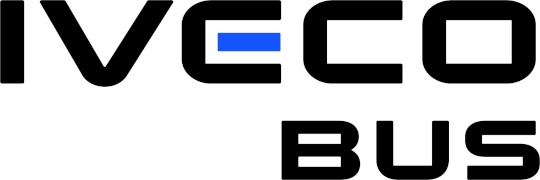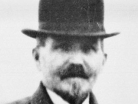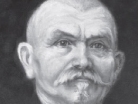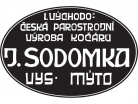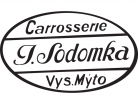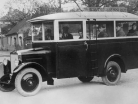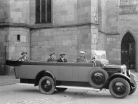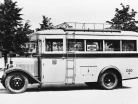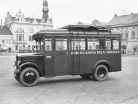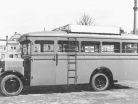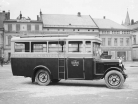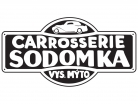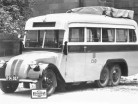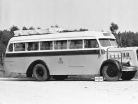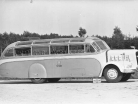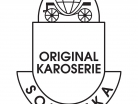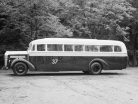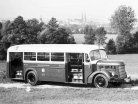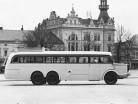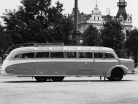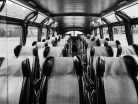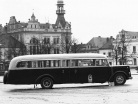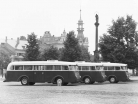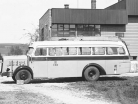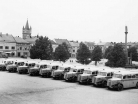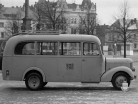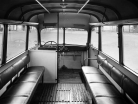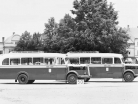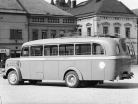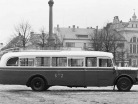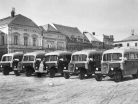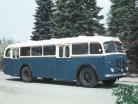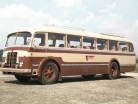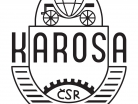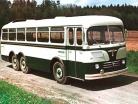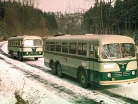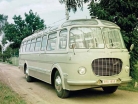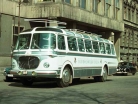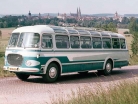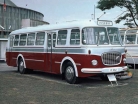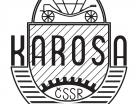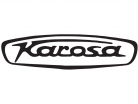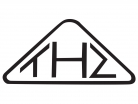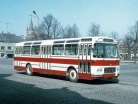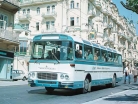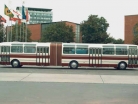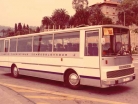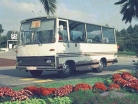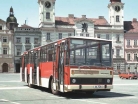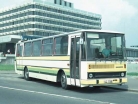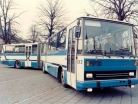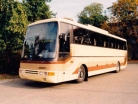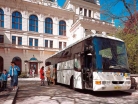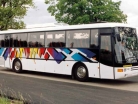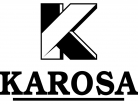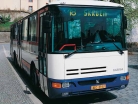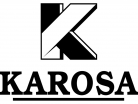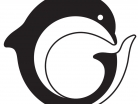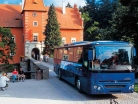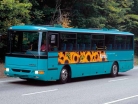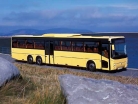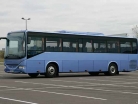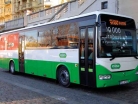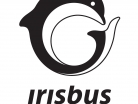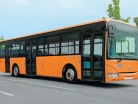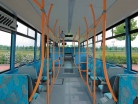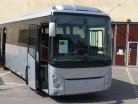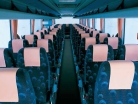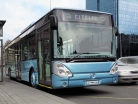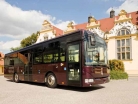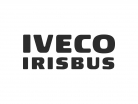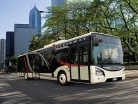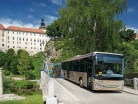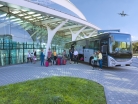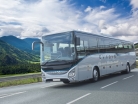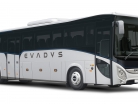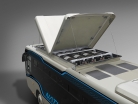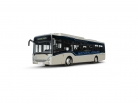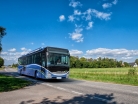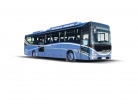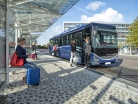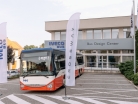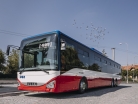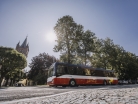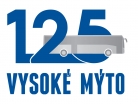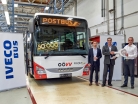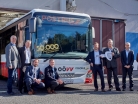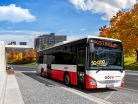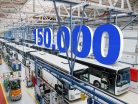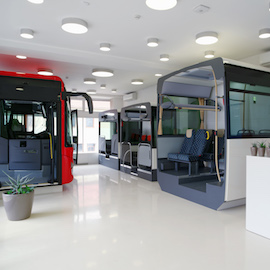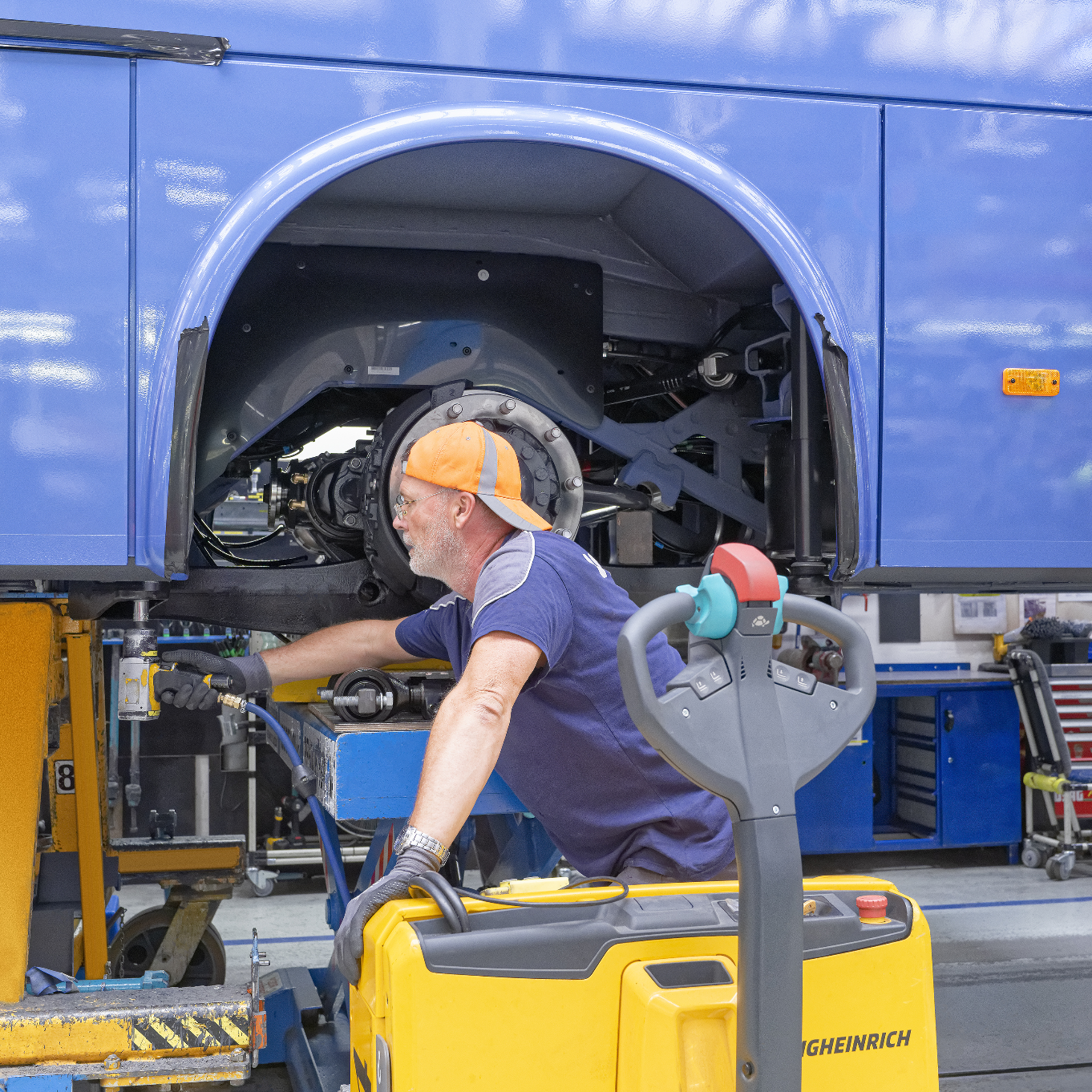We have been writing the history of public transport
The first bus of Josef Sodomka left the bodywork factory as early as in 1928.
The history of IVECO BUS in the Czech Republic goes back to 1895 when Josef Sodomka founded his wheelwright’s workshop in Vysoké Mýto. For over two decades he had manufactured mostly carriages and automobile bodies. Up to 1928, when his bodywork factory gave birth to the first 14-seat bus on a Škoda 125 chassis.
The key moment in the company history was 1948 when the company was transformed into the KAROSA state enterprise strictly specialized in bus manufacture. As early as then, KAROSA could be proud of a range of unique technological solutions and successful bus models and it ranked among the most renowned Czech enterprises. The supranational success of KAROSA is inseparably bound to its connection with the Renault and subsequently Irisbus brands in the 90s.
In 2003, IVECO became a complete owner of Irisbus and the company entered its new era which resulted in the change of the Irisbus brand to IVECO BUS in 2013. Thanks to our experience and the strong background of the supranational CNH Industrial group, our buses sell successfully all over the world today.




The first manufactured bus
On the basis of Sodomka’s drawings, the first bus body was manufactured on a Škoda 125 chassis, for fourteen passengers, and afterwards also other bus bodies on Praga, Škoda, Tatra and Walter chassis. Until the end of the year, the factory had manufactured six buses in total, one of which, the so-called “spa” bus, was endowed with an open body.

1928–1936
Between 1928 and 1936, the factory kept on with the piece manufacture of buses the look of which respected customers’ individual wishes. They were built on Škoda, Tatra and Walter chassis, one was manufactured on a Graham chassis. Until 1936, forty buses left the gates of the factory.

The manufacture on the Tatra 82 and Škoda 606 DN chassis
Thanks to state contracts, twelve identical bodies on the Tatra 82 chassis were manufactured in 1937, followed by a series of seventeen buses built on the Škoda 606 DN chassis for Czechoslovak State Railways. One of these vehicles, designed for the Prague – Karlovy Vary line, was manufactured as a luxurious coach.

The manufacture on the Praga NDO chassis
In 1938, buses on the Praga NDO chassis started to be manufactured in city bus and tourist coach modifications. First vehicles were built for public transport operators in Brno and Olomouc, while during the war the main customer was the Czech-Moravian Railways (ČMD). The mixed wood-metal construction, used at the beginning of the manufacture, was later replaced with the all-metal construction. Another significant contract was a series of fifty buses designed for participants in the 11th Sokol Gathering Festival which took place in Prague in 1948. The vehicles were equipped with two wide four-wing pneumatic doors and the Praga-Wilson automatic 5-speed transmission. 195 Praga NDO buses in total were manufactured in Vysoké Mýto.

The manufacture on the Tatra 24/67 and Tatra 24/58 chassis
Between 1939 and 1940, Sodomka’s factory manufactured seven line buses on the Tatra 24/67 chassis and six luxury coaches on the Tatra 24/58 chassis. Aerodynamic shapes of these coaches indisputably rank among highlights of Sodomka’s work in the field of bus bodies, and also their interior could boast of a very deluxe interior for that time. After May 1945, probably another coach Tatra 24/58 was manufactured in the factory, meant for the town of Olomouc. The total amount of buses manufactured on the Tatra 24 chassis reached fourteen vehicles.

The manufacture on the Škoda 706 N chassis
In 1940, the Škoda 706 N chassis were used for the manufacture of ten buses for the Czech-Moravian Railways (ČMD), equipped with lengthwise-placed seats to transport passengers for short distance. In 1945, the Škoda 706 N vehicles were manufactured on virtually the same chassis, with only one difference: the wheelbase was lengthened from 4.600 mm (706 N) to 5.400 mm (706 ND). The factory manufactured 20 buses of this type in total.

The manufacture of the Praga RN small buses
Since 1942 the factory had been manufacturing the Praga RN small buses equipped with petrol engines, designed for the Czech-Moravian Railways (ČMD). Then the same vehicles were also supplied to other customers, e.g. city public transport operators. A mixed wood-metal construction was used in the manufacture at the beginning, later it was replaced with the all-metal construction. There were 162 vehicles of this type manufactured in total.

The manufacture of the Škoda 706 GN (GND) buses with gas aggregate
In 1942 the protectorate government ordered a series of fifty Škoda 706 GN (GND) buses with gas aggregate, and Sodomka’s company solved the integration of the gas aggregate into the body in quite an aesthetic way. The buses were supplied to the Ministry of Transport for the Protectorate Railways of Bohemia and Moravia (ČMB–BMB), to city transport operators in Brno, Ostrava, Olomouc and Hradec Králové as well as to private operators.

The manufacture on the German chassis Saurer 4CP
A series of buses on the German chassis Saurer 4CP were manufactured for the Slovak Railways in 1942. As a follow-up to this contract, the Czechoslovak Railways (ČSD) ordered another series of these vehicles for the same customer at the turn of 1945 and 1946. About twenty buses in total were thus supplied to Slovakia.

The manufacture on the Škoda 256 B chassis
Between 1946 and 1947, the body workshop of Josef Sodomka manufactured buses on the Škoda 256 B chassis. These small vehicles were made in several variations, with lengthwise or transverse orientation of seats for no more than 25 passengers. Their main purchaser was the Czechoslovak Railways (ČSD), but there were also other customers among other companies and organizations throughout the country, e.g. the Headquarters of the National Security Forces in Bratislava purchased 38 of them. Four buses were manufactured for the Czechoslovak Airlines. At least 150 of these vehicles were manufactured in total.

The manufacture on the Škoda 706 RO chassis
In 1947, the company launched the manufacture of buses on the Škoda 706 RO chassis, which went on even after the founding of the Karosa state enterprise. They became the key product of the factory in Vysoké Mýto, and during ten years 2,916 of these buses were manufactured in versions for city, intercity and coach transport. Thanks to their low demands and reliability they were very popular both in Czechoslovakia and abroad where a significant part of production was exported.


The manufacture of the Karosa T 500 HB mountain buses
From 1954 the state enterprise manufactured the Karosa T 500 HB mountain buses, medium-size vehicles for 60 passengers. The aim of this project, realized in cooperation with Tatra Kopřivnice, was to provide transport in demanding mountain conditions. The equipment of these three-axle buses with a semi-self-supporting body included the Tatra air-cooled engines placed in the rear part of the body, which was a globally unique solution at that time. 524 of these vehicles in total were manufactured until 1957.

The new luxurious Škoda 706 RTO coach
At the Exhibition of Czechoslovak Engineering in Brno in 1956, Karosa presented a new luxury coach Škoda 706 RTO built on a modernized chassis from the LIAZ Jablonec state enterprise. This vehicle with an exceptionally successful design, the typical features of which included round shapes of the body and large glass surfaces on the sides and the roof, won the admiration both of specialists and non-professional public. The series production of these buses went on until 1971. The Brussels World Fair EXPO 58 witnessed a premiere of a luxurious RTO coach with an exceptional interior equipment with a buffet, changing room, radio and TV set. The RTO buses were very popular and thanks to their qualities, which included the elegant look, reliability and low fuel consumption, they became a legend. They were also used for special purposes, e.g. as service vehicles, mobile groceries, service vehicles, postal vans, mobile libraries and X-ray vans, or as surgical buses. Progressive prototypes based on the RTO range included also an articulated bus. In total, Karosa produced 14,969 buses of this type, in versions for city, intercity line a and coach transport, and a substantial part of the production was exported to many countries in Europe, Asia, Africa and South America.

The manufacture of the Š 11 range buses
Karosa had been gradually developing the manufacture of buses of the Š 11 range from 1965. The city version represented the basic type from which the intercity line and coach versions were derived. The vehicles were equipped with the horizontal Liaz ML 634 engine situated, together with the gearbox, under the floor between axles. The drivability of the bus was significantly improved by air suspension, unique with respect to global trends at that time, and also the used unique technology was “ahead” of the world standards – the whole vehicle was composed of six main panels manufactured separately, including the surface treatment and almost the complete equipment. The engine and other driving-gears were fixed to the body grid, to which were then bolted other completed panels, one by one, on the production line. This simple and revolutionary method of production meant huge progress for bus production at Karosa. Several other variations were later created as well, e.g. the Evropabus long-distance coach with a “rotel” sleeper trailer, various service vehicles, mobile libraries and also the luxurious ŠD 11 Superflux coach which won a huge recognition and was awarded with a Silver Cup at the Nice exhibition in 1969. At the same time, also 15-vehicle testing series of articulated bus were developed and manufactured. In total, 26,669 buses of the Š 11 range were manufactured, while almost 20 % of this production was exported.

A novelty: A 7 m long bus built on an Avia-Saviem chassis
A short, 7 m long bus built on an Avia-Saviem chassis, both in a line and long-distance version, became a novelty of 1969. A small series of 13 vehicles were manufactured in 1972, modified for the Czechoslovak Radio in Prague and Bratislava. Karosa manufactured thirteen of them in total.

The new 700 range
The successful and popular “ŠMs” were replaced with the new 700 range the manufacture of which was also based on the panel structure system. However, the key innovation was the engine and gearbox shifted behind the rear axle. The more modern construction and improved technology of the product also helped to raise the volume of the production up to fourteen vehicles a day between 1981 and 1990. The basic model of this range was the Karosa C 734 intercity line bus equipped with the Liaz ML 636 turbocharged engine with a Praga mechanical transmission. This type was then followed by city buses with an automatic transmission, suburban buses with a mechanical transmission, as well as intercity and long-distance coaches. The concept of the 700 range enabled to manufacture also articulated buses on the same assembly line. From the beginning of the series manufacture in 1981 to its end in 1999, the production plant produced 37,166 vehicles of this range in total.

The KAROSA state enterprise (included in the LIAZ enterprise)
1986
The KAROSA state enterprise
1988
The new luxurious LC 757 HD 12 long-distance coach
In 1992, Karosa offered its customers a novelty in the form of the luxurious LC 757 HD 12 long-distance coach which won the Golden Medal at the Autotec exhibition in Prague. The vehicle with a raised floor met the most demanding requirements on long-distance passenger transport, and, apart from air-conditioning and other important safety features, it could boast of luxurious equipment, e.g. a kitchenette, refrigerator, WC and a video system. The vehicle was driven by a vertical Cummins engine, situated behind the rear axle, later replaced with a Renault. The 12 m long coach took in 41–47 seated passengers, depending on its equipment quality level, and its maximum speed was 100 km/h. Until the end of the millennium the number of these vehicles manufactured in Karosa reached 98.

The KAROSA joint stock company, Vysoké Mýto
The privatization brought a significant change: on 1st July 1993, the Karosa joint stock company (1,706 employees) was established, specialized in the bus manufacture. The remaining production plants of the former Karosa state enterprise become independent privatized enterprises. Negotiations with the French company Renault V.I. resulted on 2nd November 1993 in the foundation of a joint undertaking, Renault V.I. holding a share of 34 % and the European Bank for Reconstruction and Development holding a share of 17 %.

The assortment extended with the new GT 11 long-distance coach
The assortment of long-distance coaches manufactured by Karosa was extended in 1994 with the GT 11 type the shape of which was based on the luxurious Karosa HD 12 coach. In the following years, the production of these tourist coaches reached seventeen vehicles.

New buses of the 900 range
In this year, Karosa manufactures and introduces to the market the first bus of the 900 range, the overall score of which was 12,944 manufactured vehicles in the end. This bus is the first one to carry the Renault logo.
After the privatization of the enterprise in 1993, Karosa commenced the development of the new 900 product range the overall score of which was 12,944 manufactured vehicles in the end. This bus was the first one to carry the Renault logo. These vehicles were modernized and converted buses of the previous 700 range whose reconstruction focused especially on the innovation of the body design, more comfort both for driver and passengers and increased quality and lifetime of the vehicles. Another significant benefit was their ecological operation. The first B 931 vehicles sold as early as at the end of 1995, while all the remaining types, i.e. line buses, long-distance and tourist coaches, were being introduced to the market gradually between 1996 and 1997. They were equipped with the Liaz ML 636 or Renault 6-cylinder engines meeting the Euro II emission standards and imported VOITH or ZF gearboxes.

Irisbus holding
A joint undertaking of the Italian company Iveco and the French company Renault V.I. was established on 1st December 1999 to coordinate the purchase of strategic components, industrial politics and development. This new Irisbus Holding S.L. group acquired a 94% share in Karosa. By unifying their activities in the field of bus and coach manufacture, the Iveco and Renault companies created an undertaking of international dimensions – the second largest manufacturer in Europe and a prominent global company. In this company, Renault V.I. owned a 50% share and the other 50% share was owned by Iveco.

The introduction of the new 950 range with Iveco Euro III engines
The next innovation of the 900 range buses brought their prolongation to 12 metres. In 2002, the new 950 range was introduced to the Karosa assembly line, with Iveco Euro III engines. Nevertheless, the modernization involved also a significant part of the chassis and body, therefore the innovation had an impact also on other aggregates, e.g. the intercity and long-distance buses were equipped with disc brakes, which contributed to their safe operation. From July 2001, all types of vehicles had been receiving the cataphoretic (anti-corrosion) immersion treatment. The manufacture of the successful 900 range ceased in 2006, with the total score of 13,071 manufactured buses.

A novelty: The 15 m long large-capacity three-axle Ares intercity bus
In 2002, the product assortment of Karosa offered the large-capacity three-axle Ares intercity bus with the length of 15 m, which took in 106 passengers. The subsequent year this production range introduced also the 12m and 10.6m lengths. The Ares vehicles were equipped with Renault Euro III engines and the German gearboxes ZF. Karosa manufactured 303 of them in total until 2006.

Iveco and synergy in the manufacture of new buses
From 1st January 2004, when Iveco became a 100% owner of Irisbus, opportunities in business policy and production have increased significantly. Now the company designers can participate in common projects more considerably and this synergy has brought the Arway, Crossway and Récréo buses manufactured until today. The Arway model had been manufactured from 2005 in the lengths of 12 m, 12.8 m and 15 m. From 2006, the company has been manufacturing the Crossway intercity buses and the Récréo school bus in lengths of 10.6 m, 12 m and 12.8 m, both meeting the Euro IV emission standards.


The presentation of the partly low-floor Crossway Low Entry bus
In 2007, the partly low-floor Crossway Low Entry bus was presented in the 12m and 12.8m lengths, which later proved to be a significant type for the development of the company. These vehicles, designed for city or intercity transport, have a 6-cylinder Iveco engine with a ZF or VOITH gearbox and a top-class body design. They are fully able to compete with the top world brands and a major part of the production from Vysoké Mýto is exported to many European countries. In 2008, the Arway vehicles were modernized and started to be manufactured also in the 10.6m length. 18,786 of these buses in total were produced till the end of 2013 and they have been manufactured till today.

The launch of the manufacture of the luxurious long-distance Evadys H coaches
In 2009, the Vysoké Mýto production plant launched the manufacture of the luxurious long-distance Evadys H coaches. The vehicles in the 12m and 12.8m lengths for 55 and 59 passengers were driven by the Iveco Cursor 10 engines meeting Euro V emission standards. The production of this type was concluded in 2014, with the total score of 180 manufactured vehicles.

The manufacture of the city low-floor Citelis buses
From 2010, the city low-floor Citelis buses had been manufactured in Vysoké Mýto, spacious modern vehicles meeting the most demanding requirements on comfort and safety of passengers. They were produced in lengths of 10.5 m and 12 m, with the classic Iveco Cursor 8 diesel engine or in CNG version, or as a body for trolleybus construction. Until the conclusion of the manufacture in 2014, the Iveco Czech Republic production plant had manufactured 593 Citelis vehicles. In 2011, the Crossway LE model was extended with a 10.7 m long version.

The 85th anniversary of bus manufacture
The 85th anniversary of bus manufacture in Vysoké Mýto. Over 116,500 vehicles manufactured up to this time.

Iveco Bus
“The new Iveco Bus brand strengthens the identity of this business with other international activities of the company. This way it supports development and perception of the whole bus product range as an unambiguous part of Iveco, especially in the markets like Europe, South America and China where the company has a significant position,” states the official declaration of the company. The production plant in Vysoké Mýto is the biggest manufacturer of Iveco buses.

The official Iveco Bus brand and the presentation of the new Urbanway city bus
In May 2013, Iveco Bus has become the official name of the brand, and the new Urbanway bus was presented, meeting the strictest Euro VI emission standards. In October of the same year, the new Crossway model range of intercity and suburban bus was introduced to the market under this brand. This development project took four years and it was quite important to the company from Vysoké Mýto. The main target of this development was to manufacture top-quality and reliable buses the operation of which will improve customers’ economic results. For the first time in history, development involved really demanding road testings. Before the first vehicle was manufactured and customized at the request of a customer, test buses had covered over 2,000,000 km in the most demanding conditions. Iveco Czech Republic, a. s. is one of the biggest employers in the region and actively participates in the development of the town and the whole region. Almost 3,000 employees participate in the manufacture of up to 17 buses a day, and further jobs the company creates thanks to its cooperation with many suppliers. Today it is evident that buses from Vysoké Mýto are able to beat the strongest competition, which fact is proved by satisfied customers both from the Czech Republic and abroad.

The 120th anniversary of the company’s founding
The 120th anniversary of the company’s founding by Josef Sodomka

Iveco Bus presents new Evadys at the Czechbus fair
The new tourist coach from Vysoké Mýto was presented for the first time in the Czech Republic at the Czechbus 2016 fair. The main benefits of new Evadys are unrivalled universality and economic operation. The disposition of Evadys is a link between the Crossway and Magelys models and thus it completes the range of Iveco Bus tourist coaches.
The new Evadys has been specially designed to meet the growing demands of regional and nationwide lines, as well as demands of short- and medium-distance tourist coach transport – demands focused on top-class services combined for both line and trip transport.
Simply put, the new Evadys is ideally suited to travels with frequent stops for which classic touring coaches are less suited but which are long enough to require perfect performance and comfort for passengers.


Crossway Natural Power
IVECO BUS presented the new Crossway Natural Power bus at the Letnany trade fair and for the third time won the award "Sustainable Bus of the Year".
This Crossway was presented for the first time in October 2018 at the Autocar Expo in France. The vehicle won the ‘Sustainable Bus of the Year 2020’ award in the intercity bus category following the previous successes with the Crealis In-Motion-Charging and Crossway Low Entry Natural Power vehicles.

40,000th Crossway
IVECO BUS reached another important milestone delivering its 40,000th Crossway to ARRIVA Czech Republic on August 26th in its Vysoke Myto plant. This new record production confirms the European leadership of the Crossway range on the intercity segment.
Already recognized as the European leader in the intercity segment, particularly in France, Italy, Germany and Eastern Europe, the Crossway breaks today new ground, reaching the record production of 40,000 units. Extremely popular with both private transport companies and public transport authorities, it confirms once again its ability to convince customers thanks to its profitability and polyvalence.

Iveco Czech Republic commemorates 125 years since its founding
Iveco Czech Republic is commemorating 125 years since its founding. The history of today's vehicles manufacture in Vysoké Mýto began in 1895, when Josef Sodomka founded a carriages workshop there. The production of carriages was followed by the world-famous and very elegant passenger cars, practical trailers and superstructures, special utility vehicles and legendary bus models from Karosa to the present. The company has overcome the historical reversals and numerous ownership changes and today, with its brand IVECO BUS, is a major bus manufacturer .

50,000th Crossway
The CROSSWAY range reached a new record with 50,000 units produced. With 50,000 produced units, the CROSSWAY range is the intercity world-wide best-seller. The CROSSWAY has been highly successful in all over Europe but also in Africa. This 50,000th unit will be delivered to ÖBB Postbus, the largest bus company in Austria and operator of most of the intercity bus network.
In 15 years, the CROSSWAY has become the benchmark in the intercity segment. With its multiple variants (10.7, 12, 13 and 14.5 m), and its engines powered by diesel or biogas, the CROSSWAY range thus satisfies all customer needs, whatever the mission. Designed to combine operating profitability, versatility and performance, the CROSSWAY range is the ideal choice for transport companies.

IVECO BUS celebrates 150 000 buses manufactured in Vysoké Mýto
The IVECO BUS plant in Vysoké Mýto is celebrating in March 2022 the 150,000th bus rolled off its assembly lines, 127 years after the first vehicle produced at this plant. This event is testament to the quality and efficiency of a factory that has evolved continuously and has now positioned itself as a benchmark, mainly in the intercity segment with the CROSSWAY production.


